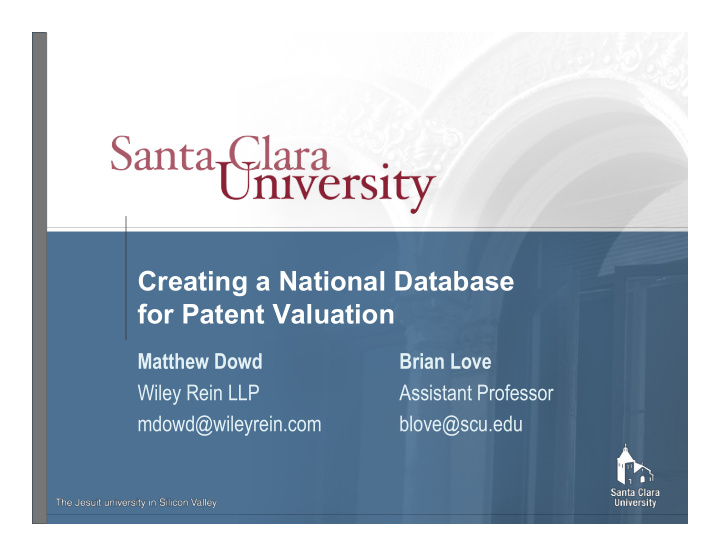



Creating a National Database for Patent Valuation Matthew Dowd Brian Love Wiley Rein LLP Assistant Professor mdowd@wileyrein.com blove@scu.edu
General Idea Others have proposed the creation of the national patent license database – Lemley & Myhrvold, How to Make a Patent Market (2007) But no one has taken a close look at the specifics: – Who administers the database? Public or private? – What information is gathered? – On what authority? – What is disclosed to the public? – Can this data be introduced in court?
Background Reasonable royalties: patent law’s punching bag – Setting a RR “involve[s] more the talents of a conjurer than those of a judge.” (Fromson v. Western Litho (Fed. Cir. 1988)) – Judge Michel, even, has noted “ massive unclarity ” about RRs ( Lucent v. Gateway oral args) Why are they so hard to calculate?
Background At core, we are trying to recreate a market rate – Georgia-Pacific Factor 1: “established royalty”? – Factor 2: Rates paid “other patents comparable to the patent in suit”? – Factor 12: Rates “customary in the particular business or in comparable businesses”? – Factor 15: hypothetical, willing negotiation – Caveat: assuming ‘valid and infringed’ ex post is important, too
Background … But no market to recreate: real world patent licenses are virtually always kept secret “[I]gnorance of prices permits unscrupulous patent owners to ‘hold up’ companies that make products by demanding a high royalty from a jury that has no way of knowing what the patent is actually worth.” (Lemley & Myhrvold)
Background Worse still, public licenses are highly skewed – Those few disclosed in litigation are tiny or huge Experts' royalty estimates sometimes diverge by 10,000% or more (Golden, ‘ Patent Trolls’ and Patent Remedies ) – Those disclosed otherwise are large “most significant source of public patent licenses is federal securities law filings, which require disclosure … if it is material” (Lemley & Shapiro, Patent Holdup and Royalty Stacking )
The Solution Lemley & Myhrvold – “The solution is straightforward--require publication of patent assignment and license terms.” But is it really so simple to implement?
Could It Be Voluntary or Market-Driven? Voluntary program? • WIPO tried: As of 2012, PCT applicants can request that interest in licensing be indicated on PATENTSCOPE website. • Of >220,000 pub’d in 2012, only 35 checked the box so far! Industry associations? • Lifesciences not likely to embrace • High Tech: Why bother if trolls not bound, too? • 3Ps intervening in Apple v. Samsung
Our Proposal Compulsory, Federally-Administered – Require the disclosure of all patent licenses – Report them to the public in manner that is as specific as possible, while maintaining anonymity (of specific transactions/patents/parties)
Which Agency? Legislation needed? PTO Pros: Already has the power? No legislation needed? 35 U.S.C. § 2(a)(2): “subject to the policy direction of the Secretary of Commerce…shall be responsible for disseminating to the public information with respect to patents and trademarks” Cons: PTO track record with info dissemination not great (Colleen Chien, Rethinking Patent Disclosure )
Licensing Data Collect: – Value: percentage rate, or lump sum value – Scope: exclusive or non; duration; geography; – Others: size of licensor/licensee Disseminate: – Rough ranges of $ values / % royalties – Broken down by tech categories, based on PTO classifications – Not a max, min, or recommendation. Just a sanity check.
Possible Stumbling Blocks Arguments about loss of confidentiality Database designed to provide confidentiality Regardless, Patentees already disclose licenses to FDA, SEC in certain circumtances. PTO, FDA, SEC, FTC, DOJ already handle confidential business information, sky has not fallen
Possible Stumbling Blocks Privilege (FRCP 26, FRE 501) – Was recognized by some cts: 6 th Circuit, some districts – But no longer (for patent cases anyway) In re MSTG (Fed. Cir. April 9, 2012) Inadmissible (FRE 408) – 10th Cir: “408 does not require the exclusion of evidence regarding the settlement of a claim different from the one litigated” 7th Cir., 8th Cir. agree – Some courts have excluded 3P settlements on limited basis, though
Possible Stumbling Blocks Gamesmanship / Standard Practice – Lump sums – ↑ number of patents – Incorporate other IP/knowhow into price Still useful: Posner in Apple v. Motorola : – “One patent is 1 percent of 100 patents and 1 percent of $700 million is $7 million. But according to [expert] declaration, the license fee for that single patent … would be “up to” 40 to 50 percent of the royalty for the entire portfolio—that is, up to $350 million.” A sanity check, not a recommendation
How you can help What road blocks are we missing? What data collection/dissemination specifics would you suggest?
Recommend
More recommend